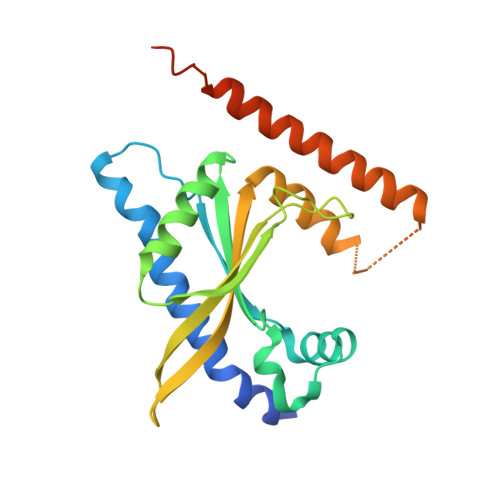Catalytic mechanism and allosteric regulation of an oligomeric (p)ppGpp synthetase by an alarmone.
Steinchen, W., Schuhmacher, J.S., Altegoer, F., Fage, C.D., Srinivasan, V., Linne, U., Marahiel, M.A., Bange, G.(2015) Proc Natl Acad Sci U S A 112: 13348-13353
- PubMed: 26460002
- DOI: https://doi.org/10.1073/pnas.1505271112
- Primary Citation of Related Structures:
5DEC, 5DED, 5F2V - PubMed Abstract:
Nucleotide-based second messengers serve in the response of living organisms to environmental changes. In bacteria and plant chloroplasts, guanosine tetraphosphate (ppGpp) and guanosine pentaphosphate (pppGpp) [collectively named "(p)ppGpp"] act as alarmones that globally reprogram cellular physiology during various stress conditions. Enzymes of the RelA/SpoT homology (RSH) family synthesize (p)ppGpp by transferring pyrophosphate from ATP to GDP or GTP. Little is known about the catalytic mechanism and regulation of alarmone synthesis. It also is unclear whether ppGpp and pppGpp execute different functions. Here, we unravel the mechanism and allosteric regulation of the highly cooperative alarmone synthetase small alarmone synthetase 1 (SAS1) from Bacillus subtilis. We determine that the catalytic pathway of (p)ppGpp synthesis involves a sequentially ordered substrate binding, activation of ATP in a strained conformation, and transfer of pyrophosphate through a nucleophilic substitution (SN2) reaction. We show that pppGpp-but not ppGpp-positively regulates SAS1 at an allosteric site. Although the physiological significance remains to be elucidated, we establish the structural and mechanistic basis for a biological activity in which ppGpp and pppGpp execute different functional roles.
Organizational Affiliation:
LOEWE Center for Synthetic Microbiology, Philipps University Marburg, 35043 Marburg, Germany; Department of Chemistry, Philipps University Marburg, 35043 Marburg, Germany.
















